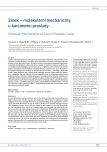Oropharyngeal Mucositis – Pain Management
Authors:
S. Vokurka
Authors‘ workplace:
Hematologicko-onkologické oddělení, Fakultní nemocnice Plzeň
Published in:
Klin Onkol 2011; 24(4): 278-280
Category:
Reviews
Overview
Oropharyngeal mucositis is a clinically significant and painful complication of an intensive chemotherapy or head and neck radiotherapy. The management of a patient in risk of this complication must include appropriate and generally recommended prophylactic measures. An effective and safe treatment must be offered to patients who have developed oropharyngeal mucositis. The basic care involves local mouthwashes, sprays or viscous gels with variable effect on pain reduction. In more serious cases, tramadol and morphine are the drugs of choice; transdermal fentanyl or buprenorphine can be considered as an alternative. Pain management must be individualized.
Key words:
mucositis – pain – analgesics – fentanyl – buprenorphine
Sources
1. Pála M, Holečková P, Veselý J et al. Konkomitantní chemoradioterapie v léčbě nádorů ORL oblasti. Výsledky ÚRO 2002–2005. Klin Onkol 2007; 20(3): 248–252.
2. Keefe DM, Schubert MM, Elting LS et al. Updated clinical practice guidelines for the prevention and treatment of mucositis. Cancer 2007; 109(5): 820–831.
3. Peterson D, Bensadoun RJ, Roila F. ESMO Guidelines Working Group. Management of oral and gastrointestinal mucositis: ESMO clinical recommendations. Ann Oncol 2009; 20 (Suppl 4): 174–177.
4. Bensinger W, Schubert M, Ang KK et al. NCCN Task Force Report, prevention and management of mucositis in cancer care. J Natl Compr Canc Netw 2008; 6 (Suppl 1): S1–S21.
5. Tontschev G. Léčba bolestí pomocí implantovaného injekčního systému a portabilní pumpy. Klin Onkol 1991; 4(3): 88–90.
6. Vorlíček J, Hep A, Vorlíčková H. Léčba bolesti u onkologických nemocných. Klin Onkol 1993; 6(6): 171–175.
7. Doležal T, Hakl M, Kozák J et al. Metodické pokyny pro farmakoterapii nádorové bolesti. Klin Onkol 2004; 17(3): 114–118.
8. Hřib R, Hakl M. Výsledky sledování FEN-PAIN-1 u onkologické bolesti, jejich analýza a komentář. Klin Onkol 2005; 18(2): 51–54.
9. Papas AS, Clark RE, Martuscelli G et al. A prospective, randomized trial for the prevention of mucositis in patients undergoing hematopoietic stem cell transplantation. Bone Marrow Transplant 2003; 31(8): 705–712.
10. Markiewicz M, Dzierzak Mietla M, Zielinska P et al. Caphosol mouth rinse diminishes oral mucositis in allo--HSCT recipients. Blood 2010; 116: 3498.
11. Miyamoto C, Wobb J, Micaily B et al. A retrospective match controlled study of supersaturated calcium phosphate oral rinse vs. supportive care for radiation induced oral mucositis. Support Care Cancer 2009; 17(7): 857–1039.
12. Barber C, Powell R, Ellis A et al. Comparing pain control and ability to eat and drink with standard therapy vs Gelclair: a preliminary, double centre, randomised controlled trial on patients with radiotherapy-induced oral mucositis. Support Care Cancer 2007; 15(4): 427–440.
13. Flook C, Calman F, Mant M et al. Gelclair vs Benzydamine in randomise controlled study in patients with oral mucositis due to readical radiotherapy. Support Care Cancer 2005; 13: 443–444.
14. Innocenti M, Moscatelli G, Lopez S. Efficacy of gelclair in reducing pain in palliative care patients with oral lesions: preliminary findings form an open pilot study. J Pain Symptom Manage 2002; 24(5): 456–457.
15. Škardová J, Kabátová-Maxová K, Vokurka S. Nové možnosti ošetřování mukozitidy dutiny ústní u pacientů po transplantaci krvetvorných buněk. Vnitřní lékařství 2008; 54: P91.
16. Lever SA, Dupuis LL, Chan HS. Comparative evaluation of benzydamine oral rinse in childern with anti-neoplastic-induced stomatitis. Drug Intell Clin Pharm 1987; 21(4): 369–361.
17. Prada A, Chiesa F. Effects of benzydamine on the oral mucositis during antineoplastic radiotherypy and/or intra-arterial chemotherapy. Int J Tissue React 1987; 9(2): 115–119.
18. Cerchietti LC, Navigante AH, Bonomi MR et al. Effect of topical morphine for mucositis-associated pain following concomitant chemoradiotherapy for head and neck carcinoma. Cancer 2002; 95(10): 2230–2236.
19. Cerchietti LC, Navigante AH, Körte MW et al. Potential utility of the peripheral analgesic properties of morphine in stomatitis-related pain: a pilot study. Pain 2003; 105(1–2): 265–273.
20. Haritha C, Shankar V. Oral morphine gargles: a cost effective approach for pain relief in patients with chemoradiation induced acute oral mucositis in head and neck cancers. J Clin Oncol 2009; 27: Abstract 20504.
21. Epstein JB, Epstein JD, Epstein MS et al. Oral doxepin rinse: the analgesic effect and duration of pain reduction in patients with oral mucositis due to cancer therapy. Anesth Analg 2006; 103(2): 465–470.
22. Strupp C, Sudhoff T, Germing U et al. Transdermal fentanyl during high-dose chemotherapy and autologous stem cell support. Oncol Rep 2000; 7(3): 659–661.
23. Cai Q, Huang H, Sun X et al. Efficacy and safety of transdermal fentanyl for treatment of oral mucositis pain caused by chemotherapy. Expert Opin Pharmacother 2008; 9(18): 3137–3144.
24. Demarosi F, Lodi G, Soligo D et al. Transdermal fentanyl in HSCT patients: an open trial using transdermal fentanyl for the treatment of oral mucositis pain. Bone Marrow Transplant 2004; 33(12): 1247–1251.
25. Kim JG, Sohn SK, Kim DH et al. Effectiveness of transdermal fentanyl patch for treatment of acute pain due to oral mucositis in patients receiving stem cell transplantation. Transplant Proc 2005; 37(10): 4488–4491.
26. Huscher A, Smussi I, Borghetti P et al. Transdermal buprenorphine for oropharyngeal mucositis-associated pain in patients treated with radiotherapy for head and neck cancer. J Palliat Med 2010; 13(4): 357–358.
27. Vokurka S, Skardova J, Karas M et al. Oropharyngeal mucositis pain treatment with transdermal buprenorphine in patients after allogeneic stem cell transplantation. J Pain Symptom Manage 2010; 39(6): e4–e6.
Labels
Paediatric clinical oncology Surgery Clinical oncologyArticle was published in
Clinical Oncology

2011 Issue 4
- Metamizole vs. Tramadol in Postoperative Analgesia
- Metamizole at a Glance and in Practice – Effective Non-Opioid Analgesic for All Ages
- Possibilities of Using Metamizole in the Treatment of Acute Primary Headaches
- Current Insights into the Antispasmodic and Analgesic Effects of Metamizole on the Gastrointestinal Tract
- Spasmolytic Effect of Metamizole
Most read in this issue
- Oropharyngeal Mucositis – Pain Management
- Schnitzler Syndrome: Diagnostics and Treatment
- Molecular Mechanisms of Zinc in Prostate Cancer
- The Role of Procalcitonin in the Differencial Diagnosis of Fever in Patiens with Multiple Myeloma
